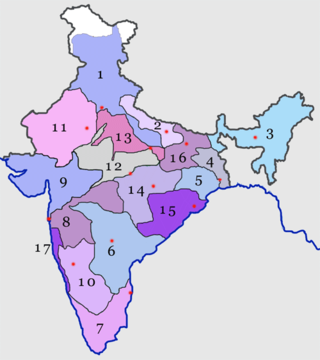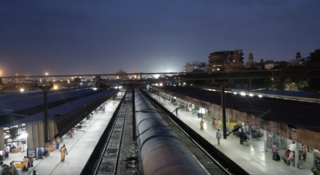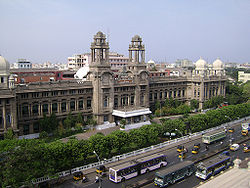
Tambaram is a southern suburb of Chennai, India. Located in the Chengalpattu district of Tamil Nadu, it is governed by Tambaram City Municipal Corporation and is a part of the Chennai Metropolitan Area.

The Southern Railway, headquartered at Chennai, is one of the 19 zones of Indian Railways. It is the earliest of the 19 zones of the Indian Railways created in independent India. It was created on 14 April 1951 by merging three state railways, namely, the Madras and Southern Mahratta Railway, the South Indian Railway Company, and the Mysore State Railway. The South Indian Railway was originally created in the British colonial times as Great Southern of India Railway Co founded in Britain in 1853 and registered in 1859. Its original headquarters was in Tiruchirappalli (Trichy) and was registered as a company in London only in 1890. At present, after re-organization of existing railway zones and creation of new zones undertaken by the Indian Railways between 2002 and 2003, Southern Railway has emerged as the 4th largest zone after undertaking some gauge conversion projects and creation of new lines. The trains operated by the southern railway are rated the cleanest as well as cleanly maintained trains of the Indian Railways.

Transport in Chennai includes various modes of air, sea, road and rail transportation in the city and its suburbs. Chennai's economic development has been closely tied to its port and transport infrastructure, and it is considered one of the best infrastructure systems in India.
Chennai Egmore, formerly known as Madras Egmore, also known as Chennai Elumbur, is a railway station in Chennai, Tamil Nadu, India. Situated in the neighborhood of Egmore, it is one of the four intercity railway terminals in the city; the other three are Chennai Central railway station, Tambaram railway station and Chennai Beach railway station. The station was built in 1906–1908 as the terminus of the South Indian Railway Company. The building built in Gothic style is one of the prominent landmarks of Chennai. The main entrance to the station is situated on Gandhi-Irwin Road and the rear entrance on Poonamallee High Road.

Puratchi Thalaivar Dr. M.G. Ramachandran Central Railway Station, commonly known as Chennai Central, is the main railway terminus in the city of Chennai, Tamil Nadu, India. It is the busiest railway station in South India and one of the most important hubs in the country. It is connected to Moore Market Complex railway station, Puratchi Thalaivar Dr. M.G. Ramachandran Central metro station, Chennai Park railway station, and Chennai Park Town railway station. It is about 1.8 km (1.1 mi) from the Chennai Egmore railway station. The terminus connects the city to northern India, including Kolkata, Mumbai, and New Delhi and all the different parts of India.
Egmore is a neighbourhood of Chennai, India. Situated on the northern banks of the Coovum River, Egmore is an important residential area as well as a commercial and transportation hub. The Egmore Railway Station was the main terminus of the Madras and Southern Mahratta Railway and later, the metre gauge section of the Southern division of the Indian Railways. It continues to be an important railway junction. The Government Museum, Chennai is also situated in Egmore. Other important institutions based in Egmore include the Government Women and Children's Hospital, the Tamil Nadu State Archives and the Tamil Nadu Archaeology Department. The Wesley Church, Egmore is the oldest church of the region.

Chennai architecture is a confluence of many architectural styles. From ancient Tamil temples built by the Pallavas, to the Indo-Saracenic style of the colonial era, to 20th-century steel and chrome of skyscrapers. Chennai has a colonial core in the port area, surrounded by progressively newer areas as one travels away from the port, punctuated with old temples, churches and mosques.

Perambur Loco Works is a suburban railway station in the Perambur area of the city of Chennai, in Tamil Nadu, in India. It serves the Integral Coach Factory (ICF) that is one of the largest railroad carriage and locomotive manufacturers in the world. The station serves growing areas like Periyar Nagar and Jawahar Nagar localities in the north-west corner of Chennai. The station has an elevation of 7.01 m above sea level.

Chennai Beach is a railway terminus of the Southern Railway network in Parry's Corner, Chennai, India. Built on reclaimed land, the station serves the suburban services of the Chennai Suburban Railway and Mass Rapid Transit System (Chennai) and a few passenger trains. It serves as the northern terminus for the Chennai MRTS line. The station is named after High Court Beach, which was later built up as part of Chennai Port, and not after the Marina Beach, which is located a few kilometres away and is served by Chepauk, Triplicane and Lighthouse stations of the MRTS line. The station consists of 1500 square metres of open parking area.

The Chennai Suburban Railway is a commuter rail system in the city of Chennai, Tamil Nadu, India, operated by the Southern Railways branch of Indian Railways. It is the second largest suburban rail network in terms of route length and the third largest in terms of commuters in India. Around 1,000 services are operated daily between 4:00 a.m. and midnight. It is the longest suburban circular route in India covering of 235.5 km (146.3 mi).

Guntur Railway Division is one of the three divisions of the South Coast Railway zone of Indian Railways. The division was sanctioned in 1995–96 and was fully operational on 1 April 2003, with its headquarters at Guntur. The Rail Vikas Bhavan in Pattabhipuram area of Guntur, serves as the office of Divisional Railway Manager. The present divisional manager is V.G.Bhooma.

George Town is a neighbourhood in Chennai, Tamil Nadu, India. It is near the Fort Saint George, Chennai. It is also known as Muthialpet and Parry's corner. It is an historical area of Chennai city from where its expansion began in the 1640s. It extends from the Bay of Bengal in the east to Park town on the west. The Fort St. George is on the south, to Royapuram in the north. The Fort St. George houses the Tamil Nadu Legislative Assembly and the Secretariat. The High court of Tamil Nadu at Chennai, Dr. Ambedkar Law College, Stanley Medical College and Hospital are located here.

The Madras and Southern Mahratta Railway was a railway company that operated in southern India. It was founded on 1 January 1908 by merging the Madras Railway and the Southern Mahratta Railway.

Perambur railway station is in Perambur, Chennai, one of the important stations in Chennai, in the Chennai Beach/Chennai Central–Arakkonam section of the Chennai Suburban Railway network. This passenger station serves the city railway colony with its Southern Railway Headquarters Hospital and works, which have their own stations, Perambur Carriage Works railway station and Perambur Loco Works railway station.

Tambaram, is one of the railway terminals of the Chennai Beach–Tambaram section of the Chennai Suburban Railway Network. It is situated at a distance of 6 kilometres (3.7 mi) from the centre of Tambaram. It is situated in South Chennai and located 27 kilometres (17 mi) from Chennai Beach station. It is one of the fastest-growing railway hubs outside Chennai Central in the southern direction. Every day, on an average, around 3,50,000 commuters use the station. About 500 suburban electric trains operate from Tambaram, including those between Chennai Beach and Chengalpattu and Kancheepuram. Further, more than 25 express trains, including those bound for Howrah and other places in the northern India, pass through the town. It is also the third busiest station in the city. It is one of the four railway terminals within Chennai City. The daily ticket sales at Tambaram fetch ₹ 1 million, half of which comes from suburban travellers. It is the second most revenue-generating station in Chennai after Moore Market Complex. A total of 52 trains pass through the station.
T. Samynada Pillai was a building contractor who constructed many prominent buildings in South India.

Royapuram railway station is a railway station at Royapuram, on the Chennai Beach–Walajapet section of the Chennai Suburban Railway network in Chennai, India. It is the second oldest railway station currently operational in India after Howrah railway station situated in Howrah, West Bengal and the first railway station of South India. The first train of South India started operating in June 1856 from Royapuram railway station. The station also remained the headquarters of the Madras and Southern Mahratta Railway till 1922, when the headquarters was shifted to Egmore. Since the original structures of Bombay and Thane stations no longer exist, Royapuram station remains the oldest railway station in the entire subcontinent.
Chennai, with historically rich records dating at least from the time of the Pallavas, houses 2,467 heritage buildings within its metropolitan area (CMA), the highest within any metropolitan area limit in India. Most of these buildings are around 200 years old and older. Chennai is home to the second largest collection of heritage buildings in the country, after Kolkata. The official list of heritage buildings was compiled by the Justice E. Padmanabhan committee. The Tamil Nadu Assembly passed the Heritage Commission Act in 2012 to preserve old heritage structures.

The Chennai Egmore–Thanjavur main line connects Chennai Egmore and Thanjavur Junction both in the Indian state of Tamil Nadu. The Chennai Egmore–Thanjavur main line is part of Chennai–Viluppuram–Chidambaram-Mayiladuthurai–Kumbakonam–Thanjavur–Tiruchirappalli line. There are several branch lines : Chengalpattu–Arakkonam links to Chennai Central–Bengaluru City line, Guntakal–Chennai Egmore section, Viluppuram–Puducherry, Cuddalore–Virudhachalam, Mayiladuthurai–Thiruvarur, and Peralam–Nagapattinam sectors. The line connects the Kaveri delta to Chennai.

Royapettah is a neighbourhood of Chennai, India.

















